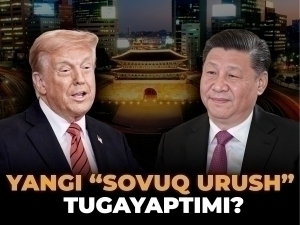Copyright qalampir

The global economy is expected to experience significant turbulence as relations between the world’s two largest economic powers — the United States and China — have unexpectedly begun to warm. During his ongoing tour across Asia, U.S. President Donald Trump may reach an agreement with Xi Jinping’s administration to resolve existing disputes. According to recent reports, on October 26 this year, during the 47th ASEAN Summit held in Kuala Lumpur, Malaysia, U.S. Treasury Secretary Scott Bessent and Chinese Vice Premier He Lifeng outlined the foundations of a new trade agreement between their countries. Both sides expressed satisfaction with the pragmatic tone of the talks. Beijing described the negotiations as constructive. According to He Lifeng, the parties reached a basic consensus on measures to address their respective challenges. “Both sides have agreed to continue negotiations on the final details,” the Chinese statement said. At the upcoming meetings in South Korea later this week, U.S. President Donald Trump and Chinese Communist Party General Secretary Xi Jinping are expected to discuss Washington’s tariff policies and Beijing’s decision to restrict rare metal exports. Trump stated that both sides are seeking to reach a mutual agreement. The exact agenda of the Trump–Xi talks in South Korea has not yet been disclosed. However, it is clear that their discussions will not be limited to the two issues mentioned above. Earlier, Beijing decided to impose stricter restrictions on the export of rare metals crucial for advanced technologies. In response, Trump threatened to introduce additional tariffs on Chinese imports. The rapid easing of tensions between the two countries has triggered mixed forecasts among experts. Disputes with China Trump’s protectionist policy has been aimed primarily at revitalizing domestic manufacturing, supporting local entrepreneurs, and restoring the United States’ former status as one of the world’s industrial leaders. His policy of imposing various tariffs on foreign exports, strengthening ties with Arab countries, increasing pressure on Venezuela, and creating opportunities for domestic businesses all point to his broader ambitions. From the late 2000s onward, Chinese products quickly emerged as competitors to American goods in the global market. The hybrid system combining Deng Xiaoping’s market economy principles with communist governance enabled China to develop at an unprecedented pace. Cheap labor and global integration acted as catalysts for this growth. Within the U.S. itself, Chinese goods — cheaper yet often comparable in quality — increasingly replaced domestic products. As a result, local businesses either went bankrupt or were forced to lower prices artificially, leading to wage reductions, job cuts, and declining product quality. This became known in history as the “Trade War.” It all began in 2018, when Trump imposed high tariffs on Chinese imports. Washington accused China of violating fair competition principles by subsidizing its companies, copying U.S. technologies without authorization, and maintaining an unfair trade imbalance. In response, China imposed tariffs on $110 billion worth of U.S. goods. This caused stock markets to tumble and disrupted global supply chains. By 2020, relations had somewhat improved. The two countries signed the “Phase One” trade agreement, under which China committed to purchasing an additional $200 billion in U.S. goods. However, the COVID-19 pandemic prevented the deal from being fully implemented. During his second presidential term, Trump again placed the support of domestic enterprises at the top of his agenda under the slogan “Make America Great Again.” Consequently, a 100 percent tariff on Chinese goods was planned — but the agreements reached in Kuala Lumpur have temporarily “frozen” this process. This trade war was, in essence, also an ideological one. As a socialist country, China found it difficult to maintain close relations with the United States, which presents itself as a defender of democracy. Beijing has long faced criticism from the West over human rights abuses, heavy censorship, the Uyghur issue, and the continued use of capital punishment. These fundamental ideological differences have made mutual understanding between the two powers nearly impossible. Goals and consequences What lies behind Trump’s dramatic policy shift? Is he admitting his mistakes, or is there a hidden agenda behind these moves? There are several possible explanations. In recent months, domestic discontent toward Trump has been growing. On October 18 this year, more than 2,500 people across various U.S. states protested his policies under the slogan “No Kings in America.” Similar demonstrations also took place in July. These protests, reflecting rising public dissatisfaction, may have pushed the administration to adjust its political trajectory. Currently, China produces about 70–80 percent of the world’s rare earth minerals — essential components used in electronic devices — which are crucial for major American tech companies. Furthermore, deeper integration between the two economies would be mutually beneficial. The Chinese market holds immense importance for the United States, just as the American market does for China. Both nations possess vast territories, large populations, and high purchasing power. The tariffs imposed for geopolitical reasons have long hindered this integration. The U.S. and China are also among the world’s largest exporters. A new trade agreement between them could stabilize global prices, strengthen confidence in the U.S. dollar, and ease inflationary pressures. As markets stabilize and currency rates strengthen, international investors’ confidence in future economic cooperation is likely to grow. Nevertheless, there are some pessimistic voices regarding the upcoming summit. Critics argue that China is not a country that would agree to just any deal, while Trump’s impulsive style and reliance on rhetoric may prevent substantial progress. Thus, many believe the two sides will struggle to reach a compromise during their meeting in Seoul. Another issue complicating matters is the long-standing Taiwan question. According to Russian media leaks, the U.S. has announced that it will not change its stance on Taiwan in exchange for improved trade relations with China. Taiwan is a global leader in microchip manufacturing, and Washington has consistently supported it. If positions on this issue remain unchanged, a comprehensive trade deal may remain out of reach. Additionally, China’s assistance could be crucial for Trump in resolving the Russia–Ukraine war. Especially after recent developments, Trump may not seek reconciliation with Putin again. His current strategy could be to isolate Russia diplomatically. Indeed, imposing heavy tariffs on China and attempting to exclude it from the political arena have naturally pushed the U.S. closer to other powerful states in Eurasia. Now, it seems Trump is determined to win China over by any means necessary. However, Beijing is also known for pursuing strategies that align strictly with its own interests. Therefore, it is highly likely that at the upcoming meeting, Washington will have to meet Xi Jinping’s demands — or the summit will simply end as another failed diplomatic show orchestrated by Trump. Temur Suvonov



